Naxos Travel Guide 2024
The largest of the Cyclades islands is also one of the most popular: long sandy beaches, clear blue water, a wealth of historical sites and low prices all combine to create the ideal family beach break destination.
Now is a great time to book a Naxos bargain: read our guide to find out if this unique island could be the perfect Greek destination for you summer getaway.
Why visit Naxos?
Beach life is the biggest attraction on Naxos, as with most Greek islands. However, many agree that Naxos is blessed with especially beautiful stretches of sand.
The finest beaches are located on the west coast. Among the best known are Plaka, Agios Prokopios (which you can read more on later in this blog), Aliko, and Sahara (Limanakia) - which are well developed tourist spots with beach bars and sunbeds.
Secluded beaches include Kastraki Beach, which is loved for its vast sand dunes and gas-blue waters. The few daily visitors tend to leave well before sunset, since there are only a couple of hotels and taverns to stay in.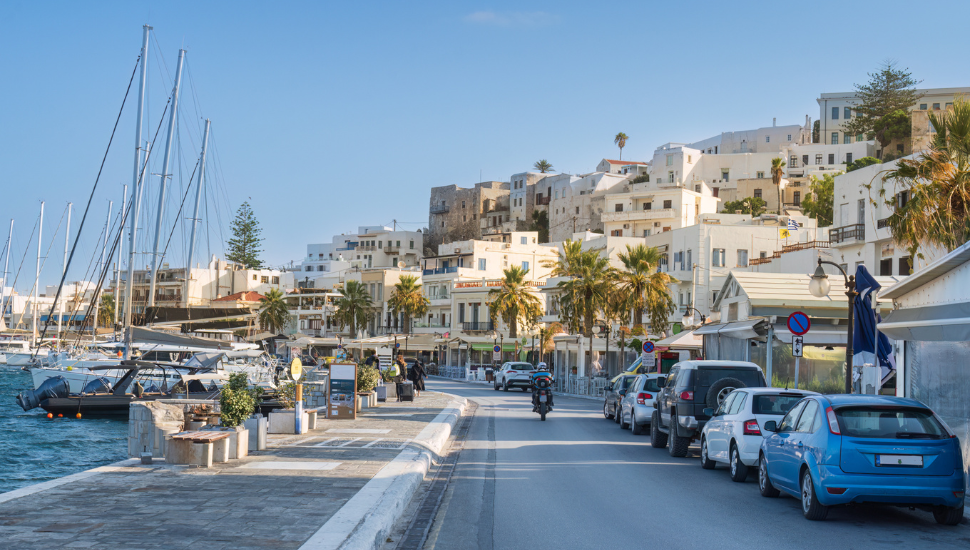
How to get around Naxos
Naxos boasts an extensive bus network which connects most of the main towns.
You'll need to buy your tickets in advance; you cannot buy them when you board. Make sure you have enough tickets to get back to your hotel at the end of the day. Tickets can be purchased from local shops.
Planning to use public transport? Ensure your hotel is located near restaurants, shops and of course a beach - so you can access the essentials by foot.
Car and moped rentals in Naxos
However, the bus network will limit how far you can go on a given day, so consider renting a moped, quadbike, or car.
Two-wheeled transport will mean parking is much easier, but four-wheeled options are best if you don't have much moped experience.
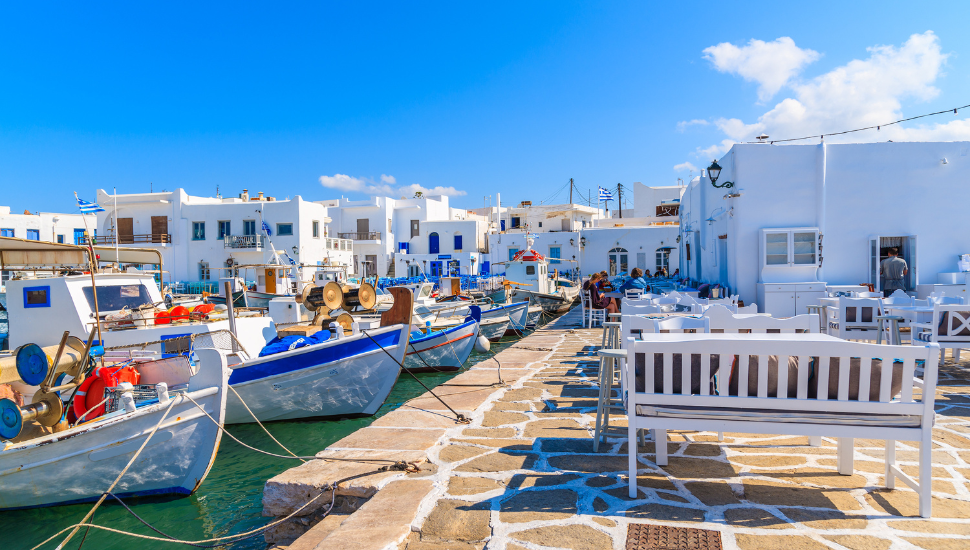
Best things to do and see in Naxos
Hora (Naxos Town) and its Venetian Kastro
NB: 'Naxos Town' and 'Hora' are used interchangeably.
The island's capital, Hora (or Chora) Naxos, is famed for its white cuboid houses and the labyrinthine alleys that connect them.
Many quaint bars and restaurants await discovery here, some with live jazz and blues.
The nightlife is focussed on Hora's seafront and while lively, is not comparable to the likes of Ayanapa and Mykonos (which will relieve some visitors!).
During the day you can go souvenir hunting or grab a pair of rugged Cyclades sandals.
And the Tsiplakis is worth a look before your return flight, so you can stock up on authentic Naxos honey, cheese and olive oil.
The Kastro
These attractions lie beneath the hilltop Kastro (castle), built by the Venetians in the 13th century.
The Kastro is also home to the island's chief archaeological museum, presenting a fascinating collection of Naxos artefacts that span the centuries.
As one of the best-preserved mediaeval castles in all of Greece, the Kastro is well worth a visit.
Agios Prokopios beach
Naxos is blessed with many wonderful beaches, but one of the finest is Agios Prokopios. This long stretch of sand is lapped by shallow waters which makes it ideal for swimming.
Sun loungers can be rented from the many beach clubs, with prices rising the closer you are to the water (and how fancy the beach club is). If you wish, you can simply order food and drink from your lounger and stay all day.
For windsurfing, head to Agios Georgios Beach in the southwest.
Glaronissia (Seagull Island)
Snorkelling and scuba diving are two of the chief activities on Naxos, and Glaronissia (aka Seagull Island) is among the best locations to enjoy them. Dramatic rock formations, undersea caves, and colourful coral have made this a popular spot.
A sailboat trip here costs between 70 and 100 euros per person.
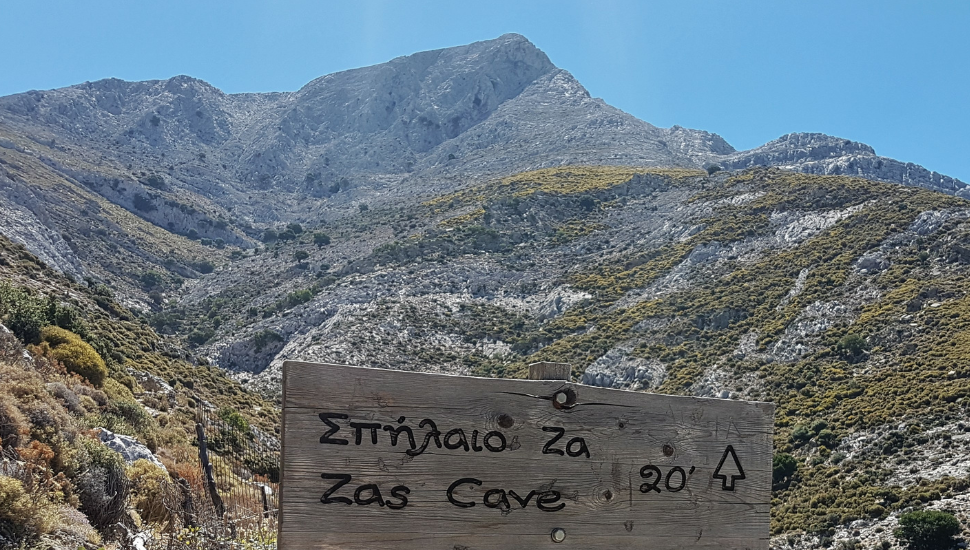
Climb Mount Zas
According to legend, Zeus was born and raised around the 1000m Mount Zas.
Despite its height, it's possible to reach the summit in about an hour - but do make sure you're wearing robust footwear, since the terrain is very rocky near the top.
It's recommended you start early in the morning so you can enjoy the sunrise and avoid the extreme heat - but it's still a rewarding hike for those who aren't early risers.
There's also a longer, more challenging route, which takes in 'the Cave of Zeus' - or Psychro Cave. Zeus, the god of the sky and all other gods, is said to have been born here (although several other Greek caves lay claim to this accolade!).
Ancient quarries
Naxos marble was much sought after in ancient times - and still is today.
You can visit several disused quarries, where the prized material was sliced out of the mountainside. Millennia-old, half-finished sculptures (notably the Kouros of Apollonas) still lie nearby.
Thanks to its ability to resist erosion, and its sparkling, gleaming visual properties, Naxos marble was transported across ancient Greece to be used in countless sculptures and monuments.
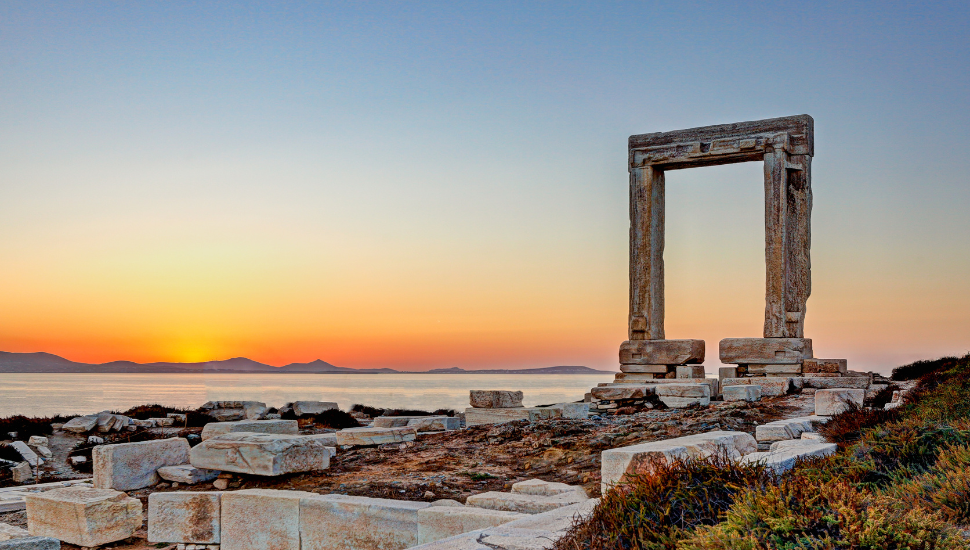
Temple of Apollo
The Temple of Apollo on Naxos is an unfinished structure on the island's north coast, near the town of Apollonas. The famous gate is still standing - but little else was completed. Four slabs of marble comprise the gate, each weighing 20 tonnes!
Artists also began carving a colossal statue (Kouros of Apollonas) for the temple, but this was abandoned and can be seen half-finished in its quarry, some distance away. Archaeologists believe the temple was dedicated to Apollo because it was built facing the God of War's birthplace.
Note that to reach this iconic temple you must walk along a very windy walkway
Portara sunsets
The iconic Portara, the unfinished gateway to the Temple of Apollo, may be simple - just two columns and a lintel - but it makes for a striking image with the glistening blue Aegean as a backdrop.
Located on the west coast, Portara is ideal for enjoying sunsets.
Bazeos Tower
Built in the 17th century, the majestic Bazeos Tower was originally built as a monastery.
The Bazeos family purchased the tower and converted it for use as an exhibition space and cultural centre.
If you're in Naxos in July and August, don’t miss the annual cultural festival, featuring music and literary readings.
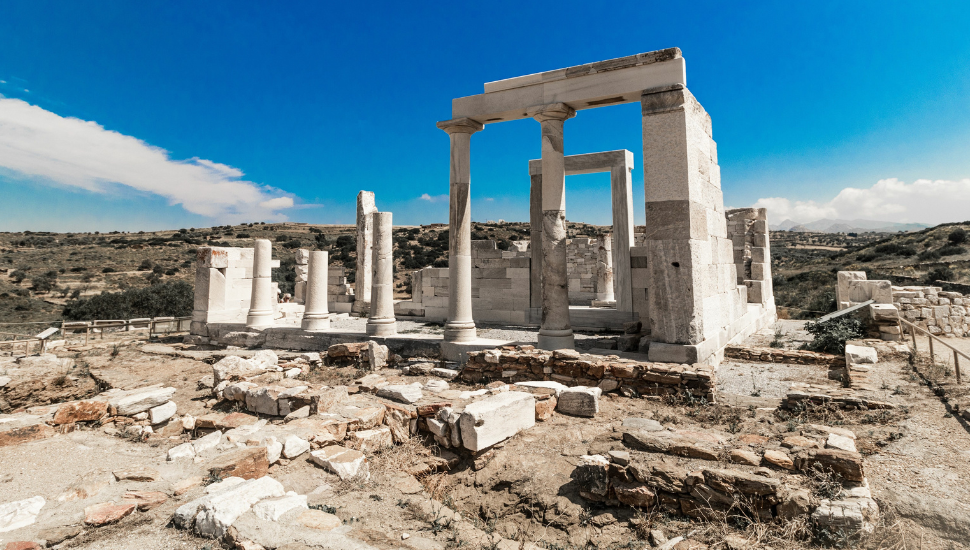
The Temple of Demeter
Located near the village of Sangri, 1okm from Naxos Town, the Temple of Demeter is a magnificent, partially restored structure that was originally built in the 6th Century BC.
The ruins were discovered in 1949, and excavated between 1976 and 1995. A small museum is located nearby where you can see the fragments not used in the restoration. The temple can be reached by bus.
Other archeological sites of Naxos
Other interesting historical sites include Kouros of Melanes and Kouros at Apollonas, Panagia Drosiani church, Kalamitsia Monastery, and the monastery of Fotodotis.
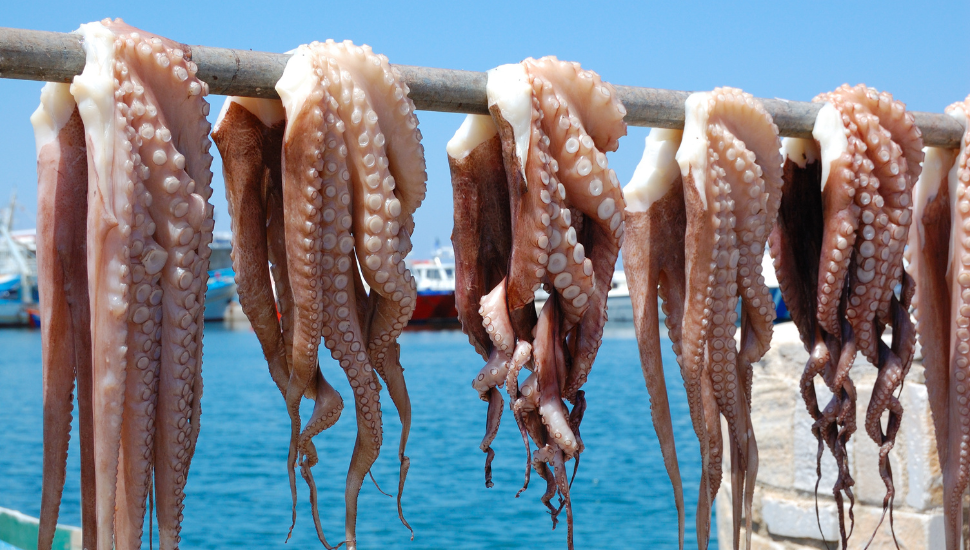
What is Naxos food like?
Greek food is world-famous - and you'll be able to enjoy all the classic dishes on your trip to Naxos.
Alongside classic Greek dishes like moussaka and souvlaki (gyros), on Naxos you can try local rooster, beef and rabbit stews (with wine), octopus (with wine) and lamb fricassee (not usually with wine).
Whether your food originated on surf or turf, you're sure to be delighted with the island's food options.
Vegetarians will love the hummus, falafel, olives and feta cheese - among many other meat-free items.
Some local specialties are worth tracking down. These include 'orange pie' comprising Greek yogurt, filo, orange juice and honey; and citron liqueur, which is exported across Greece.
What are the best restaurants on the island of Naxos?
Some of the best places to eat are tucked away among the winding backstreets of Kastro, and Hora (Naxos Town) in general.
It's worth spending some time exploring these eateries, especially the area behind the port.
Is Naxos expensive?
Naxos is cheaper than more famous islands such as Santorini or Mykonos, with a range of accommodation options available. The large hotel inventory helps keep prices low, while food and vehicle rentals are cheaper because the island is less touristy than others in the Cyclades.
However, in common with other parts of the world, prices have risen in Naxos in recent years - particularly as regards food.
How much are hotels on Naxos?
If you book ahead you can get incredible value on your hotel room. It's not uncommon to find top-rated hotel accommodation with veranda, pool and breakfast for under £40 per night.
Opt for a package deal and you could get flights, room with breakfast and transfers for well under £800 per person, based on two sharing for 7 nights.
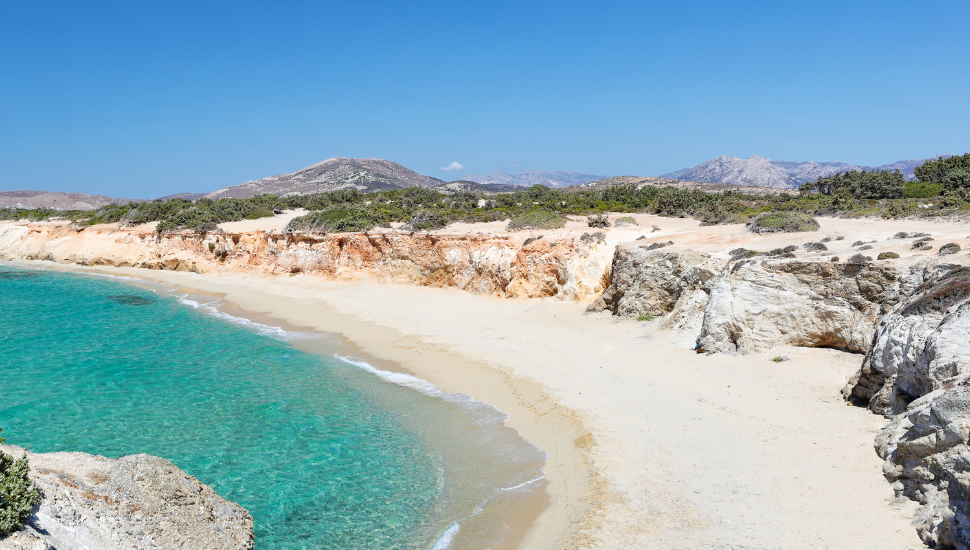
When is the best time to visit Naxos?
For the sunniest weather, visit from June to September.
Whether tanning, swimming or enjoying watersports, these months are perfect for enjoying Naxos many outdoor pursuits.
The downside to peak season visits is that you'll be sharing the island with many other tourists. This means busier beaches, restaurants and of course hotels - which will cost more in the warmer months.
By visiting in the “shoulder” months of May and October you'll experience fewer crowds, less intense heat and cheaper hotel rooms. Flights to and from Greece are also likely to be cheaper (although airfares from Athens to Naxos airport can be high year round).
How to reach Naxos from UK & Athens
Having flown into Athens from the UK, you can either fly to Naxos airport, or go by land and ferry (this being the cheaper of the two).
It takes around six hours by road and ferry to reach Naxos from the capital.
A similar time frame is involved in flying, once trips to and from airports are factored in.
The ferry option also gives you the chance to enjoy the dazzling blues of sea and sky - an experience that is only fleeting by air.
Get a Quote